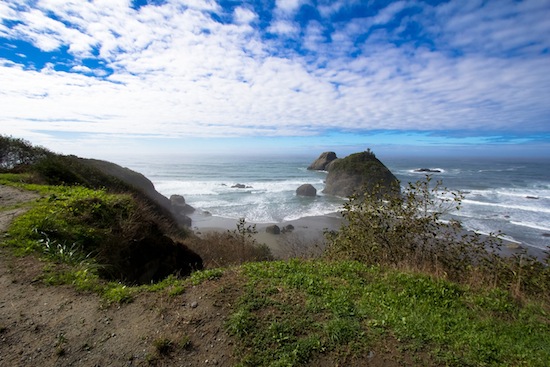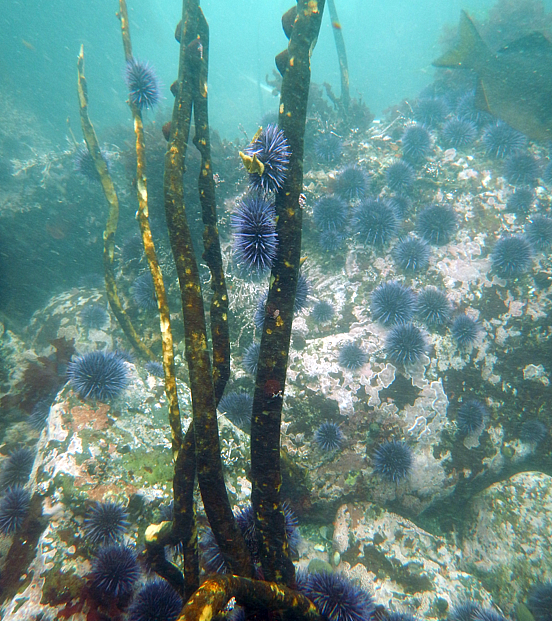Funding Area: Environment
The Greater Farallones Association (GFA) is the non-profit partner of the Greater Farallones National Marine Sanctuary. Its mission is to ensure the Sanctuary remains an ecologically diverse and globally significant ocean environment. GFA’s vision is to sustain a healthy and resilient ocean through education, science, and community involvement for the benefit of present and future generations. Its work helps to protect the wildlife and habitats of the Sanctuary through the development of a diverse community of informed and active ocean stewards.
Our involvement: The Marty Tomberg Charitable Fund has financially supported this organization.
Projects We Support
Kelp Recovery and Management Project – Phase 1
Bull kelp forms dense underwater forests that many marine organisms depend on for shelter and food along the northern California coastline. Since 2012, bull kelp forests in this region have been almost completely decimated due to a combination of unusual climate and ocean conditions, leaving the near shore ecosystem in crisis. The Kelp Recovery project will work to identify the management, restoration, and research needed to facilitate recovery and increase climate resilience of bull kelp forests and the associated nearshore fisheries that rely on them. Through collaboration with scientific agencies, management bodies, universities, tribal nations, and fishing communities, this project will produce actionable outcomes and key recommendations for the recovery of this critically important nearshore marine ecosystem.
Support Dates: April, 2018 – March, 2019
Kelp Recovery and Management Project – Phase 2
In Phase 2, the establishment of the Kelp Recovery Program, GFA will work closely with California Department of Fish and Wildlife (CDFW) and Greater Farallones National Marine Sanctuary (GFNMS) to implement the recommendations of the Kelp Recovery Working Group (Working Group). The recommendations include citizen science coordination, addressing data gaps and monitoring efforts, conducting targeted restoration efforts and engaging coastal communities and tribal nations with effective messaging and citizen science opportunities. These recommendations are currently being incorporated into a comprehensive Bull Kelp Recovery Plan which will outline specific pathways and strategies for implementation.
Support Dates: March, 2019 – March, 2020
Kelp Recovery Program – Phase 3
Following the Kelp Recovery Plan, the Kelp Recovery Network, a partnership of over 30 individuals and representatives from nonprofits, businesses, research institutions and coastal communities, intends to restore kelp forests along the coastlines of Sonoma and Mendocino counties over the next three years. GFA is responsible for three critical aspects of this effort: a) coordination of the Network, b) aerial monitoring, and c) an effective long-term citizen science program.
Collaboration and coordination with a multitude of partners is critical to the success of restoration, research, and monitoring efforts associated with kelp recovery. To effectively implement the Recovery Plan, stakeholder actions will be coordinated, interventions will be monitored to ensure unintended consequences are avoided and successful action is documented, and accurate information will be communicated to all interested parties.
Our project seeks to assess new technologies to determine the most cost effective and efficient protocols, methods, and techniques to assess kelp forest loss and recovery along the U.S. West Coast, including: plane- based aerial imagery, several satellite platforms, and UAV surveys. Plane-based surveys and procurement of satellite imagery are being funded by The Nature Conservancy (TNC) and the Ocean Protection Council, who are both close partners in the implementation of this project. The California Department of Fish and Wildlife (CDFW) historically used plane-based surveys to produce spatial maps with aerial photography, but this was discontinued because of its cost-prohibitive nature, and will most likely not be a viable long-term monitoring solution. Opportunities for satellite imagery via Landsat, Planet Labs RapidEye and Sentinel-2 are being investigated by our partners at the Universities of Los Angeles and Santa Cruz to map large-scale changes in kelp forest canopy. However, satellite imagery is ineffective in cloudy conditions, and its low resolution will likely not be able to capture finer-scale dynamics critical to kelp forest recovery assessment, especially for bull kelp- dominant ecosystems.
Support Dates: March, 2020 – March, 2021
Advancing Blue Carbon Understanding and Management in Marine Protected Areas – Phase 1
The Greater Farallones Climate Team is conducting a preliminary assessment of blue carbon in the Greater Farallones National Marine Sanctuary, with the goal of assessing how much carbon is sequestered through natural processes in seagrass, salt marshes, and other Sanctuary habitats and organisms. This information will inform important resource protection and conservation decisions for the Sanctuary.
Led by the Greater Farallones Association (GFA), in partnership with Greater Farallones and Cordell Bank National Marine Sanctuaries, this project aims to: 1) advance the understanding of blue carbon and the role it plays in the global carbon cycle, and 2) reduce atmospheric carbon and build ecosystem resilience by protecting and enhancing blue carbon, both within the Sanctuaries, which make up one of the largest marine protected areas (MPAs) in the country, as well as in other MPAs worldwide. This multi-year project is a priority area of focus for the Sanctuaries, as it is becoming increasingly critical for MPAs to acknowledge and advance the climate mitigation services that protected ocean areas provide.
Support Dates: March, 2021 – March, 2022
Advancing Blue Carbon Understanding and Management in Marine Protected Areas – Phase 2
In Phase 1 of this project, the Greater Farallones Climate Team completed the first assessment of blue carbon processes in a federal marine protected area (MPA) and shared those results broadly. Building on these accomplishments, Phase 2 of the project will include an expanded assessment with a focus on quantifying the carbon content of offshore marine sediments in Greater Farallones and Cordell Bank National Marine Sanctuaries.
Coastal and ocean ecosystems (like kelp forests, wetlands, and marine sediments) play an important role in carbon sequestration, but if degraded or disturbed, they can become sources of carbon emissions. In particular for marine sediments, carbon remineralization from activities such as bottom-trawling decreases the pH of the surrounding waters, exacerbating ocean acidification, threatening marine life and reducing the oceans’ capacity to absorb atmospheric carbon dioxide. Understanding the blue carbon value of marine ecosystems in MPAs helps managers make informed decisions about resource protection. GFA will provide the findings from its Phase 2 blue carbon assessment to Sanctuary and MPA managers nationally and internationally to support them in making informed conservation decisions for their coast and ocean resources.
Support Dates: March, 2022 – April, 2023
Advancing Blue Carbon Understanding and Management in Marine Protected Areas – Phase 3
Marine sediments are the largest non-fossil pool of organic carbon on the planet, yet are not well studied or protected. Thanks to continued support from Tomberg Philanthropies, in Phase 3 of this project, our primary goal is to advance our understanding of marine sediments and their protection as a climate mitigation strategy in marine protected areas (MPAs). Our Phase 3 project objectives are to:
- Provide novel data produced during Phases 1 and 2 to the National Oceanographic and Atmospheric Administration’s Greater Farallones and Cordell Bank National Marine Sanctuaries to incorporate blue carbon findings into its upcoming management plan review. Demonstrating the value of blue carbon in the ecosystem incentivizes protection of important coastal ocean resources that marine life and coastal communities depend on.
- Maintaining an international presence on the inclusion of blue carbon in climate mitigation policies across regions. Working with the Sanctuaries and international partners, we will bolster the evidence base around the role of MPAs and biodiversity in tackling climate change to further the impact of this work.
- Increase awareness of the importance of marine sediments in climate mitigation through sharing our marine sediment carbon analyses and findings related to implications for MPA management and blue carbon protection broadly.
Support Dates: March, 2023 – – March, 2024
Organization and Project Photos
Kelp Recovery Project Photos




